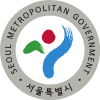
Seoul
Capital of South Korea / From Wikipedia, the free encyclopedia
Dear Wikiwand AI, let's keep it short by simply answering these key questions:
Can you list the top facts and stats about Seoul?
Summarize this article for a 10 year old
Seoul,[lower-alpha 2] officially Seoul Special City,[lower-alpha 3] is the capital and largest city of South Korea. The broader Seoul Capital Area, encompassing Gyeonggi province and Incheon metropolitan city, emerged as the world's fourth largest metropolitan economy in 2014, trailing only Tokyo, New York City, and Los Angeles, hosting more than half of South Korea's population. Although Seoul's population peaked at slightly over 10 million, it has gradually decreased since 2014, standing at approximately 9.97 million residents as of 2020. Seoul is the seat of the South Korean government.
Seoul
서울 | |
|---|---|
| Seoul Special City 서울특별시 | |
| transcription(s) | |
| • Hangul | 서울특별시 |
| • Hanja[lower-alpha 1] | 서울特別市 |
| • Revised Romanisation | Seoul-Teukbyeolsi |
| • McCune–Reischauer | Sŏul-T'ŭkpyŏlsi |
| Motto(s): "Seoul, my soul"[1] | |
| Anthem: none[2] | |
| Coordinates: 37°33′36″N 126°59′24″E | |
| Country | Republic of Korea |
| Area | Seoul Capital |
| Founded by | Taejo of Joseon |
| Districts | 25 districts |
| Government | |
| • Type | Mayor–council |
| • Body | Seoul Metropolitan Government Seoul Metropolitan Council |
| • Mayor | Oh Se-hoon (People Power) |
| • National Assembly | 49 |
| Area | |
| • Special city | 605.21 km2 (233.67 sq mi) |
| • Metro | 12,685 km2 (4,898 sq mi) |
| Elevation | 38 m (125 ft) |
| Highest elevation | 836.5 m (2,744.4 ft) |
| Lowest elevation | 0 m (0 ft) |
| Population (2Q 2023)[4] | |
| • Special city | 9,659,322 |
| • Rank | 1st |
| • Density | 16,000/km2 (41,000/sq mi) |
| • Metro | 26,037,000[5] |
| • Metro density | 2,053/km2 (5,320/sq mi) |
| • Demonym | Seoulite |
| • Dialect | Gyeonggi |
| GDP | |
| • Special city | KR₩ 486 trillion (US$ 389 billion) |
| • Metro | KR₩ 1,137 trillion (US$ 910 billion) |
| Time zone | UTC+9 (Korean Standard Time) |
| ISO 3166 code | KR-11 |
| Bird | Korean magpie |
| Color | Seoul Red[7] |
| Flower | Forsythia |
| Font | Seoul fonts (Seoul Hangang and Seoul Namsan)[8] |
| Mascot | Haechi |
| Tree | Ginkgo |
| Website | seoul.go.kr |
| Seoul | |
| Hangul | |
|---|---|
| Revised Romanization | Seoul |
| McCune–Reischauer | Sŏul |
| Seoul Special City | |
| Hangul | 서울특별시 |
| Hanja | |
| Revised Romanization | Seoul Teukbyeolsi |
| McCune–Reischauer | Sŏul T'ŭkpyŏlsi |
Seoul's history traces back to 18 BC when it was founded by the people of Baekje, one of the Three Kingdoms of Korea. During the Joseon dynasty, Seoul was officially designated as the capital, surrounded by the Fortress Wall of Seoul. In the early 20th century, Seoul was occupied by the Japanese Empire, temporarily renamed "Gyeongseong." The Korean War brought fierce battles, with Seoul changing hands four times and leaving the city mostly in ruins. Nevertheless, the city has since undergone significant reconstruction and rapid urbanization.
Seoul was rated Asia's most livable city, with the second-highest quality of life globally according to Arcadis in 2015 and a GDP per capita (PPP) of approximately $40,000. 15 Fortune Global 500 companies, including industry giants such as Samsung,[9] LG, and Hyundai, are headquartered in the Seoul Capital Area, which has major technology hubs, such as Gangnam and Digital Media City.[10] Seoul is ranked seventh in the Global Power City Index and the Global Financial Centres Index, and is one of the five leading hosts of global conferences.[11] The city has also hosted major events such as the 1986 Asian Games, the 1988 Summer Olympics, and the 2010 G20 Seoul summit.
Seoul is geographically set in a mountainous and hilly terrain, with Bukhan Mountain positioned on its northern edge. Within the Seoul Capital Area lie five UNESCO World Heritage Sites: Changdeok Palace, Hwaseong Fortress, Jongmyo Shrine, Namhansanseong, and the Royal Tombs of the Joseon dynasty.[12] Furthermore, Seoul has witnessed a surge in modern architectural development, with iconic landmarks including the N Seoul Tower, the 63 Building, the Lotte World Tower, the Dongdaemun Design Plaza, Lotte World, the Trade Tower, COEX, IFC Seoul, and Parc1. Seoul was named the World Design Capital in 2010 and has served as the national hub for the music, entertainment, and cultural industries that have propelled K-pop and the Korean Wave to international prominence.










